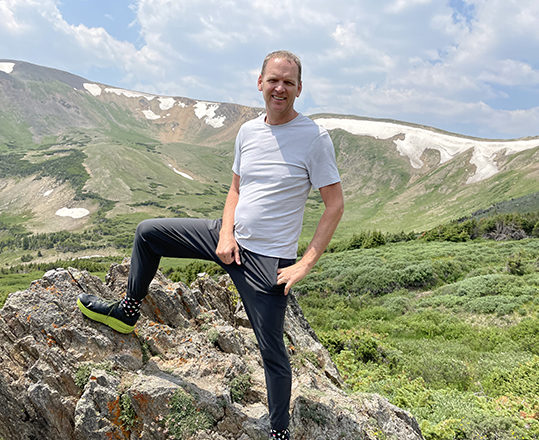Clint Covington knows first-hand what it feels like to be excluded and left behind.
“I grew up on a pig, goat, and mink farm in Utah, and there were times when I’d show up at school smelling like a farm animal,” he recalled. “Some kids were cruel.”
Clint was also placed in a remedial learning program from first through eighth grade, and he struggled with reading, writing, spelling, and math (partially due to possible dyslexia). He entered seventh grade with a second-grade reading level. With the help of a dedicated special education teacher, a librarian, and his supportive family, he eventually caught up with his peers and was able to go on to college, ultimately earning a master’s degree from Utah State University.
So, when the Microsoft veteran was tapped in 2015 to lead accessibility efforts for Office products, he felt like his life experiences gave him some insight into—and empathy for—the challenges faced by underrepresented communities.
“My struggles in school, and with dyslexia—that’s what made me resilient,” Clint said. “That experience instilled a growth mindset and an awareness of other people’s journeys. I’m extremely dedicated to making more inclusive products; that’s now my superpower.”
To help celebrate Global Accessibility Awareness Day (May 19th), we spoke to Clint about his journey in tech, his strong belief in the importance of accessibility to using Microsoft products, and how Office Insiders contribute to this mission.
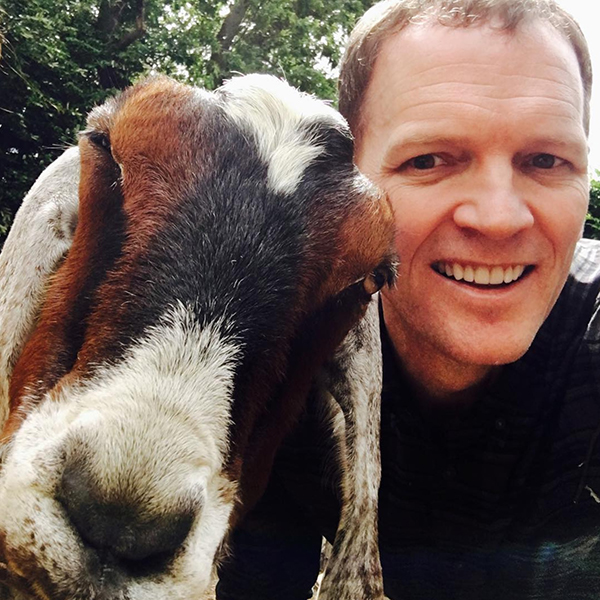
Did you set out to work in technology from an early age?
Clint: No. I had no intention of going to college; I assumed I would raise mink. But then we lost our farm to bankruptcy when I was 16, and I spent summers doing hard labor in an auto body shop. That was unfulfilling work, so it sent me off to college with motivation to find a new career path. I struggled academically at first, but I poured my heart and soul into every course and earned my bachelor’s degree in economics from the University of Utah.
I was interested in how people learn and the role technology plays in education, which directed me towards a master’s in instructional technology. I also had an entrepreneurial drive, and I turned my passion for fly fishing into a business. With the help of a master fly tyer, I created short videos about how to tie flies and combined them to create FlyTy, a multimedia training course sold on CD-ROM at Kmart and boutique fishing shops (this was before the internet was a thing). We even sold advertising placements in the program.
Eventually, I sent a resume to Microsoft, and I was hired to work on the Microsoft Access team in 1998. And I’m still here at the company.
How did you come to work on accessibility?
I developed an interest in user experience design from building Access databases, and I transitioned to the Shared User Experiences team. There I led the effort to support touch and motion in the Office experience.
While a colleague was on leave, I was asked to fill in and lead accessibility issues for my team. Around the same time, Microsoft was seeing signals from employees and customers that we needed to step up our game to deliver more accessible experiences.
I spent a lot of time listening to people with disabilities that had lived experiences, as well as visiting with our government customers. I learned from people who were using our technology in the workplace that we had opportunities to update their experiences.
It was through these conversations that I realized that the choices and actions we make as engineers have a direct impact on people with disabilities. And I recognized how important it is to involve people from the disability community in every step of the product development process. There is a frequently heard mantra in the accessibility community: “Nothing about us, without us.” We build more inclusive products when we follow this philosophy.
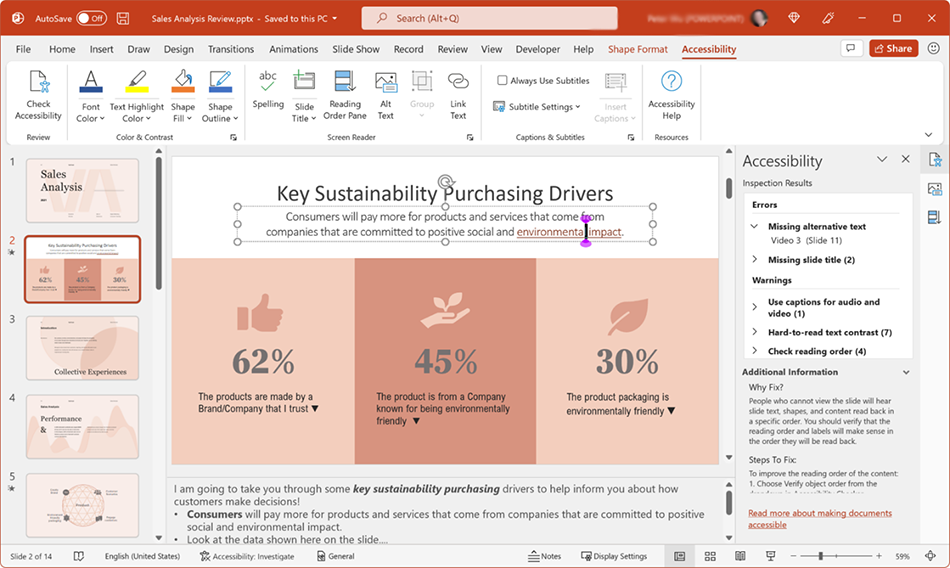 The Accessibility ribbon in PowerPoint
The Accessibility ribbon in PowerPointDo you feel that Microsoft demonstrates a commitment to inclusivity and accessibility?
I definitely do. We’re all in on inclusion. When Satya Nadella became CEO in 2014, he encouraged us to dedicate considerable time and focus to accessibility issues—to really lean in. In 2015, I joined Jenny Lay-Flurrie and a small team of deeply driven people who were committed to making our products loved and more importantly usable by people with disabilities. The team has grown since then but its mission remains the same. We are proud of the progress we’ve made and the village working on a11y, but we remain vigilant and aware that there is always more to do.
How have Office Insiders helped you with this mission of inclusivity and accessibility?
First off, I think of Office Insiders as great advocates. When we think about accessibility, sometimes we think of support for large fonts, high-contrast mode, keyboard-only users, and screen reader users. But, in the past few years, we’ve invested in “inclusive design”—a design practice that learns from people with different perspectives to “solve for one, extend to many.” We have found that by drawing from the diversity of human experiences and the unique needs of people with disabilities, we create products that are more useful for everyone.
Some examples of that would be Immersive Reader—super useful for people who have dyslexia, to improve their reading; Read Aloud—also totally useful for someone with dyslexia, but also helpful if you’re tired and you need help concentrating. There’s also Dictate—a great feature for people with mobility impairments, but also really useful for times where you have carpal tunnel, or you’ve been typing too long.
These features can benefit everyone. And Insiders help us get the word out about these features, and also give us feedback from diverse perspectives on how we’re doing in fulfilling our mission to help everyone achieve more.
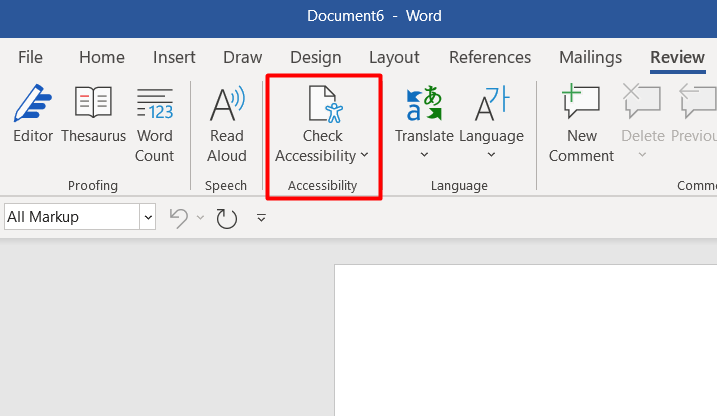
What’s your favorite Office feature?
I’m super excited to hear when people are running the Accessibility Checker to create and share accessible content. It gives each of us an opportunity to advance more equitable experiences by checking our own content to see if it’s accessible.
It might take a little bit of extra effort, but I believe content that passes the Accessibility Checker is better content for everybody, not just for people with disabilities. For that reason, we have worked to make “the checker” more visible, including an “investigate” nudge in the status bar. This simple change has increased the usage of the Accessibility Checker to a level 14 times higher in just over a year.
Why is this work so important to you, and to the company?
I feel a sense of urgency—we have so much more work to do. We know that employment and education rates are lower and poverty rates are higher for people with disabilities. And unfortunately, rates of societal inclusion for this critical community have been flat for the last 30 years. I’m humbled to be part of Microsoft’s commitment to helping people cross the disability divide. I have a hard time imagining work that more directly correlates to the Microsoft mission than helping empower people with disabilities through technology.
At one memorable moment early in my journey, I showed the picture below (of my family dressed up as superheroes) to a roomful of company executives.
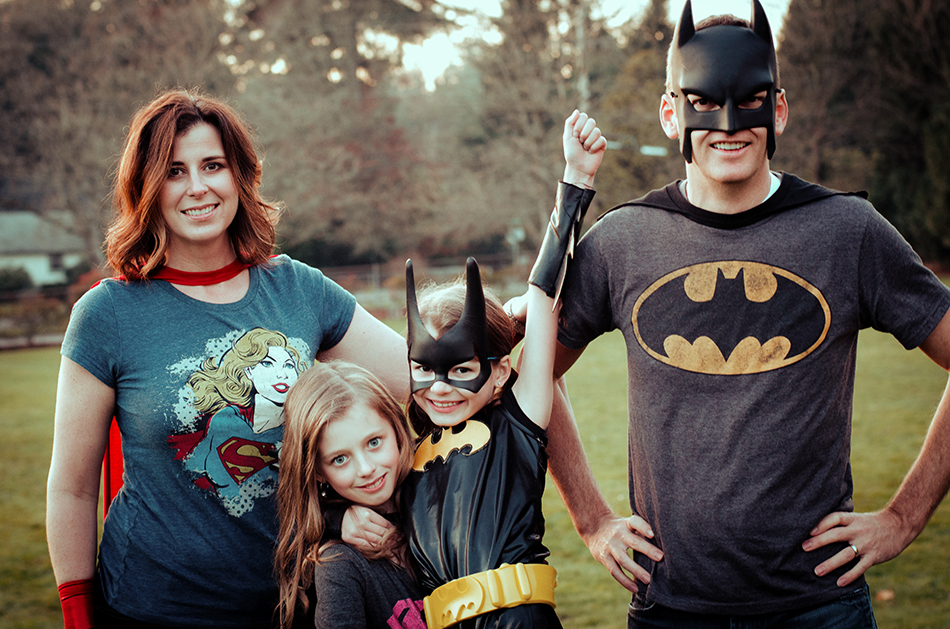
Everyone chuckled. I pointed out that without alt text on this image, a person using a screen reader would have no idea what was funny. My message got across: Run the checker!
Today, I love to nerd out with our engineers and explore how to use technology to help people work more efficiently with less effort. I want to create products that enable people with disabilities to leverage their unique talents and strengths, and to achieve more. Disability is a strength!
What’s one superhero that inspires you in real life?
I connect with Batman. He has no limits; he protects the citizens of his community. It’s what he does that defines him—it’s not about fame.
You know, I’m totally willing to let the Supermen and Wonder Women colleagues on our product teams have the limelight when they launch new innovations. My job is to provide them with the connections, processes, and feedback to create the most inclusive experiences possible. So, in that way, I’ve always liked Batman.
Be sure to sign up for the Office Insider newsletter and get the latest information about Insider features in your inbox once a month!
